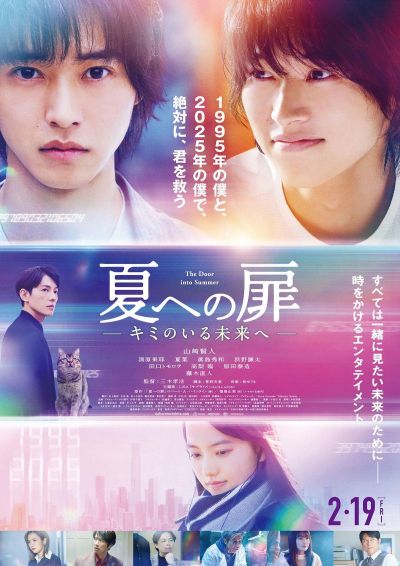The Cat Survives
The Door into Summer
By Takahiro Miki & Tomoe Kano

16 Feb, 2022
0 comments
Takahiro Miki and Tomoe Kano’s 2021 film The Door into Summer (夏への扉 キミのいる未来へ) is an adaptation of Robert A. Heinlein’s 1957 novel The Door into Summer. Directed by Miki and written by Kano, it stars Kento Yamazaki, Kaya Kiyohara, Hidekazu Mashima, Natsuna, Naohito Fujiki, and a cat whose name I failed to determine.
Soichiro Takahura (Kento Yamazaki) has experienced tragedy after tragedy. He was orphaned, then taken in by his father’s benevolent colleague Koichi Matsushita. Alas, Koichi and his wife died in a mishap soon after. Koichi’s daughter Riko (Kaya Kiyohara), briefly raised as Soichiro’s sister, was taken in by her uncle Kazuhito (Hidekazu Mashima) and although they are still close, Riko no longer shares a household with Soichiro.
By 1995 Soichiro has three things on which he can depend: his R&D work for the robotics company he co-owns with Kazuhito, the companionship of his cat Pete, and the love of his stunningly beautiful girlfriend Rin Shiraishi (Natsuna).
Probably it’s not significant that Pete hisses whenever he sees Rin.
Light spoilers
Shortly after assigning a block of voting stock to Rin, Soichiro has a very bad day. Kazuhito plans to sell the company to another firm. When Soichiro protests, the partners have a formal vote. Rin, who has been evil all along, votes with her secret lover Kazuhito. Not only will the company be sold out from under him, but Soichiro, while remaining a stockholder, is fired and all of his research equipment confiscated.
A miserable and drunken Soichiro resolves to take advantage of recently perfected cold sleep techniques and escape his troubles by fleeing (with Pete) thirty years into the future. However, the cold sleep company to whom he turns will not freeze a drunk man. When Soichiro sobers up, he resolves to stay in 1995 and fight.
His presence could be very inconvenient for Kazuhito and Rin. The partially completed cold sleep contract presents an opportunity. Rin drugs Soichiro, then uses her corporate connections to have Soichiro frozen. No Soichiro, no problem.
Thirty years later, Soichiro revives to discover he is now broke and that Pete was left behind in 1995 and is no doubt long since dead. Nor is the news regarding Riko any better: she was last seen in 1995 racing to Soichiro’s lab shortly before it exploded and burned to the ground. She has not been seen since.
Soichiro has but two resources to navigate 2025: a malfunctioning medical-aid android coincidentally named Pete (Naohito Fujiki), assigned to Soichiro for five days, and a mysterious mastermind who seems to be steering Soichiro towards some undefined goal. Who the puppet master is and what their interest in Soichiro might be is unclear, but so far nothing has worked in Soichiro’s favour….
~oOo~
Pete survives to the end of the movie.
Complaints: many subtitles were projected on backgrounds with insufficient contrast, which affected readability. Also, the 2025 plot seemed just a bit rushed.
Viewers may remember that robotics was not as advanced in our 1995 as it was in Soichiro’s. Viewers may also be aware that cold sleep was not a viable method in 1995. Although obviously the movie cannot address this—Soichiro has no idea he is a character in a movie or that his history is different from ours—there is an implied explanation. As anyone who read the novel will expect, time travel rears its head. While the novel hews to a fixed timeline, the movie mentions in passing that history can be altered. Presumably people won’t stop time travelling once Soichiro has had his jaunt to the past. Try not to be horrified by that.
Nor is this the only aspect in which the movie differs from the book. Tomoe Kano appears to have invested a fair amount of thought into how to make one of Heinlein’s creepier books into something 21stcentury viewers can enjoy. For example, the novel’s Dan Davis (the basis for Soichiro) is a smug ass who eventually turns out to be the centre of the universe he always assumed he was. Soichiro, on the other hand, spends much of the movie losing over and over; his eventual triumph is thanks to hard work and applied niceness. A kindly gesture in the past meant that a future oligarch owed him a favour; Pete the android sees him as a father figure.
Many readers familiar with the book may wonder how Tomoe Kano handled the romance between middle-aged Dan and eleven-year-old Ricky. Answer: far more adroitly than Heinlein did. First of all, Soichiro is a bit younger than Dan. Second, Riko is a lot older than Ricky: seventeen to Ricky’s eleven. Furthermore, while Riko is smitten with Soichiro, the evidence that he sees her as anything more than a beloved sibling [1] is pretty weak. As well, the entire subplot about Dan giving Ricky a road map to marrying him in the future is gone: before returning to the future, Soichiro reminds Riko that she is only seventeen and encourages her to enjoy the full life that awaits her post-1995. Like Ricky, Riko does join Soichiro in the future … but she spends the ten years before she goes into cold sleep aging up to the same age as Soichiro and establishing herself as a scientist of equal status.
Despite the subtitle problems and the pacing issues, this was an enjoyable science fiction romance. I found it superior in many respects to the source material.
The Door into Summer can be seen on Netflix and no doubt elsewhere as well.
1: And not in the Heinlein sense.
